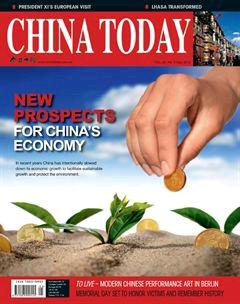Sci-Tech
China, India Collaborate on Low Carbon Research
The China-India Low Carbon Study 2014 was released at the closing of the Third Meeting of the Sino-Indian Strategic Economic Dialogue in Beijing on March 18. Xu Shaoshi, chairman of Chinas National Development and Reform Commission(NDRC), and Montek Singh Ahluwalia, deputy chairman of Indias Planning Commission, who co-chaired the meeting, commended the study.
“This report marks a new epoch in Sino-Indian cooperation,” said Mr. Xu.“In the course of upgrading growth quality, we actively conduct cooperation in lowcarbon technologies to seek an efficient mode of sustainable growth and economic restructuring.”
The study represents one of the first collaborative efforts between key research institutes in both countries working on climate changerelated issues. It examines the main factors in low carbon development – financing, low carbon technologies and on-the-ground implementation. The study builds a convincing case for exchanges between the two countries, and calls for more public sector funding for low carbon technology. It also identifies several priority areas for technical cooperation between China and India.
These include clean coal-based power production, energysaving technologies, and developing wind and solar power.
China Releases 2014 Scientific Report
The Chinese Academy of Sciences recently published its annual reports on the latest scientific findings. The series includes reports on hightech development, scientific development, and sustainable growth.
The 2014 Report on Science Development covers the latest research achievements by Chinese scientists, including the discovery of new subatomic particles and breakthroughs in the study of the H7N9 virus. It also highlights key issues that need attention towards the next 10 to 15 years, and suggests efforts towards controlling heavy metal pollution in soil and the establishment of a national emergency medicine network.
The 2014 Report on Hightech Development homes in on the forefront of global scientific research, such as artificial organs and 3D printing.
The 2014 Report on Chinas Sustainable Growth Strategy predicts that China will face steep challenge in resource management and environmental protection in the next 10 years. It calls for a top-down plan to remove structural barriers in industry upgrades and coordinated efforts in promoting energy conservation, curbing haze and reducing emissions.
China, Uzbekistan Step up Astronomical Collaboration
Chinas National Astronomical Observatories (NAO) and Uzbekistans Ulugh Beg Astronomical Institute (UBAI) agreed to step up cooperation and exchange by signing a memorandum of understanding in Beijing on March 21. Collaboration will be carried out in equipment upgrades, historical studies and frontier research in astronomical observation, as well as talent exchange and training, said NAO chief Yan Jun.
Uzbekistani Ambassador to China Daniyar Kurbanov said that astronomy is an important strategic discipline for the development of aviation and aeronautics.
Ulugh Beg Astronomical Institute is the oldest scientific institution in Central Asia. It is located south of the famous historical city of Samarkand, and is known for having ideal atmospheric conditions. As an established observatory since the Middle Ages, it has led the world in astronomical study. The cooperation will be of high value to the two countries in celestial research.
New Ship Joins Chinas Oceanic Scientific Expedition
A new scientific expedition vessel, the Xiangyanghong 10, officially joined Chinas oceanic research fleet on March 28. The 4,500-ton ship, named after Chinas first research vessel to the Antarctic, is the first scientific expedition vessel jointly built by a governmentsponsored institution and a private company. The ship has an advanced electric propelling system and dynamic positioning system, with a capacity of 12,000 nautical miles without refueling. The vessel is capable of oceanic and deepsea observation, exploration, sampling and analysis, and will serve as a mobile lab and experimentation platform for marine science research and high technology development.

